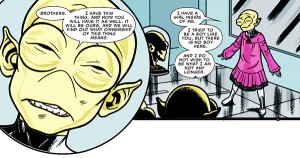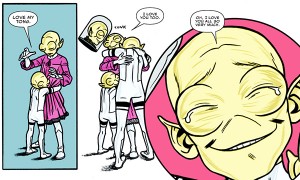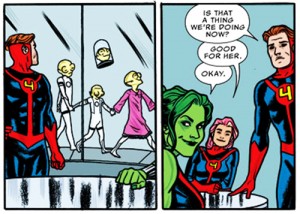 Here at PencilPanelPage we post relatively often about identity and identification (my favorite all-time post along these lines is still Quiana’s early post “Can an EC Comic Make ‘You’ Black?”). In this post I intend to continue this grand tradition. So let’s talk about my new favorite character: Tong.
Here at PencilPanelPage we post relatively often about identity and identification (my favorite all-time post along these lines is still Quiana’s early post “Can an EC Comic Make ‘You’ Black?”). In this post I intend to continue this grand tradition. So let’s talk about my new favorite character: Tong.
Tong is one of four adolescent moloids (or ‘mole-men’) who were saved by the Thing after being rejected by the other (more ‘devolved’) residents of the Forgotten City, and is taken in by the Fantastic Four (see Fantastic Four #575). Tong soon settled in with other super-powered adolescents at the special school known as the Future Foundation (the ‘FF’). Now, things get interesting when the Fantastic Four go off on a vacation in another dimension or something – they all die, but didn’t, and then I got confused!
 At any rate, the important part for our purposes (as detailed in Matt Fraction and Mike Allred’s FF volume 2) is the fact that The Future Foundation is temporarily handed over to Ant Man, who runs the school and protects the world with the assistance of She-Hulk, Medusa, and Darla Deering (in the old mechanical Thing armor). While struggling to figure out how to defeat Dr. Doom, save the world, etc., Tong discovers that she is, in fact, a girl. After donning a dress, she makes this announcement to her ‘brother’s’ (explanation for scare quotes below), and throughout the rest of the series she is identified as female.
At any rate, the important part for our purposes (as detailed in Matt Fraction and Mike Allred’s FF volume 2) is the fact that The Future Foundation is temporarily handed over to Ant Man, who runs the school and protects the world with the assistance of She-Hulk, Medusa, and Darla Deering (in the old mechanical Thing armor). While struggling to figure out how to defeat Dr. Doom, save the world, etc., Tong discovers that she is, in fact, a girl. After donning a dress, she makes this announcement to her ‘brother’s’ (explanation for scare quotes below), and throughout the rest of the series she is identified as female.
Now, I don’t want to focus on how the coming out story is told in this case (although it must be admitted that Tong’s announcement is handled in much less of a “Look, it’s a big event in comics! Hope you’re paying attention!” manner than was the introduction of a transgender character into the DC universe at roughly the same time – so kudos to Fraction and Allred for handing the story in an understated and elegant manner). What I want to think about here is the narrative potential of comics for telling this sort of story.
So here is the question: Is Tong transgender? Now, taking “transgender” on a literal reading, this would require that Tong has shifted from one distinct gender identification to another. But it is not clear that Tong really identified as male (or as having any gender or sex!) prior to her autonomous choice to self-identify as female. Of course, she and her three brothers (I’ll stop using the scare quotes, since I take it that the point of using them earlier is now becoming clear) have been identified by themselves and others as male. But it seems rather plausible that this is a sort of ‘default’ assignment due to their physical appearance. It is striking that the four young moloids rarely use singular, gendered pronouns in the comic (they usually work together, and refer to themselves communally as “we”). In the critical coming out scene it is only Tong that uses such a pronoun and, in fact, only Tong who uses the first-person pronoun “I” at all, suggesting that it is only she that in some sense has a true identity. In addition, the moloids are an engineered race, created by the High Evolutionary, and it is not clear that moloids have primary sexual characteristics of any sort (how would we understand gender identification in a culture and race that lacked biological sexes?) Heck, one of the brothers is just a disembodied head in a floating glass jar!
 I also don’t want to get into nit-picky discussions about whether or not the moloids other than Tong really do have a sex or a gender. The point I am interested in is that there doesn’t seem to be any reason (in this story at least) to assume they do at the outset. As a result, we are free to understand Tong’s choice as, in part, a decision to have a gender, rather than a decision to choose one gender over another. This, in turn, points to one of the powers of fiction – it allows us to imagine possible scenarios (such as a being without either sex or gender to actively choose to have one) that might be difficult or impossible to experience or realize in real life. In this particular case, we are confronted with a story in which gender issues play out in a way that seems distinct from how they play out in the real world (since presumably most if not all humans identify with one or another gender throughout their formative years, even if this identification is difficult and perhaps eventually abandoned for another). Considering such counterfactual scenarios could be important for our understanding of the concept of gender itself. Of course, Fraction and Allred are not the first to create stories that explore gender and sexual dynamics that are quite different from those that are usual, or even possible, within our own culture or species (Ursula Le Guin’s work comes to mind). But it is possible that comics are especially suited for this sort of exploration, because comics are (at least partially) a pictorial medium. Many of our preconceptions regarding both gender and sex are related to physical differences – that is, differences we can see. As a result, it might be the case that a pictorial medium is the ideal place to examine, explore, and subvert our preconceptions and prejudices with regard to gender and sex. It’s an interesting, and exciting, possibility.
I also don’t want to get into nit-picky discussions about whether or not the moloids other than Tong really do have a sex or a gender. The point I am interested in is that there doesn’t seem to be any reason (in this story at least) to assume they do at the outset. As a result, we are free to understand Tong’s choice as, in part, a decision to have a gender, rather than a decision to choose one gender over another. This, in turn, points to one of the powers of fiction – it allows us to imagine possible scenarios (such as a being without either sex or gender to actively choose to have one) that might be difficult or impossible to experience or realize in real life. In this particular case, we are confronted with a story in which gender issues play out in a way that seems distinct from how they play out in the real world (since presumably most if not all humans identify with one or another gender throughout their formative years, even if this identification is difficult and perhaps eventually abandoned for another). Considering such counterfactual scenarios could be important for our understanding of the concept of gender itself. Of course, Fraction and Allred are not the first to create stories that explore gender and sexual dynamics that are quite different from those that are usual, or even possible, within our own culture or species (Ursula Le Guin’s work comes to mind). But it is possible that comics are especially suited for this sort of exploration, because comics are (at least partially) a pictorial medium. Many of our preconceptions regarding both gender and sex are related to physical differences – that is, differences we can see. As a result, it might be the case that a pictorial medium is the ideal place to examine, explore, and subvert our preconceptions and prejudices with regard to gender and sex. It’s an interesting, and exciting, possibility.
So, is Tong transgender?
